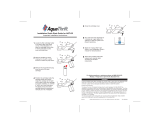
28
BEFORE USING THE APPLIANCE
SAFEGUARDING THE ENVIRONMENT
•
Your new appliance is designed exclusively for
domestic use.
For best use of your appliance, carefully read
the user’s handbook which contains a
description of the appliance and advice on
storing and preserving food.
Keep this handbook for future consultation.
1.
After unpacking, make sure that the appliance
is undamaged and that the door closes
perfectly tight. Any damage must be reported
to your dealer within 24 hours after delivery of
the appliance.
2.
Wait at least two hours before switching the
appliance on in order to ensure the refrigerant
circuit is fully efficient.
3.
Installation of the appliance and electrical
connections must be carried out by a qualified
electrician, in accordance with the
manufacturer’s instructions and local safety
regulations
4.
Clean the inside of the appliance before using it.
1.Packing
The packaging material is 100% recyclable and
carries the recycling symbol. Follow local
regulations for scrapping. Keep the packaging
materials (plastic bags, polystyrene parts, etc.)
out of reach of children, as they are potentially
dangerous.
2.Scrapping
The appliance is manufactured using recyclable
material.
This appliance is marked according to the
European directive 2002/96/EC on Waste
Electrical and Electronic Equipment (WEEE).
By making sure this appliance is disposed of
correctly, the user will help prevent potentially
negative consequences for the environment and
the health of persons.
The symbol on the appliance, or on the
accompanying documents, indicates that this
appliance should not be treated as domestic waste
but must be taken to a suitable collection point for
the recycling of electrical and electronic
equipment.
Before scrapping, make the appliance unusable
by cutting off the power cable and removing the
doors and shelves so that children cannot easily
climb inside the appliance.
Disposal must be carried out in accordance with
local environmental regulations for waste
disposal. Deliver the appliance immediately to
an authorized dump; do not leave it unattended
even for a few days, since it is potentially
dangerous for children. For more information
regarding the treatment, recovery and recycling
of this appliance, contact your local office, the
domestic waste collection service or the shop
where you purchased the product.
Information:
This appliance does not contain CFC (the
refrigerant circuit contains R134a) or HFC
(the refrigerant circuit contains R600a) (see the
rating plate inside the appliance).
Appliances with Isobutane (R600a):
isobutane is a naturally occurring, low
environmental impact gas. Caution is required,
however, because isobutane is flammable.
Therefore, ensure that the pipelines of the
refrigerant circuit do not get damaged.
Declaration of conformity
•
This appliance is designed to store food and is
manufactured in conformity with European
Directive 90/128/EEC, 02/72/EEC and
Regulation (EC) No. 1935/2004
•
This product has been designed, manufactured
and retailed in compliance with:
- the safety objectives of the Low Voltage
Directive 73/23/EEC;
- the protection requirements of the “EMC”
Directive 89/336/EEC,
amended by Directive 93/68/EEC.
•
The electrical safety of the appliance can only
be guaranteed if the product is connected to
an approved earth connection.
31502003GB.fm Page 28 Friday, May 19, 2006 11:02 AM




















